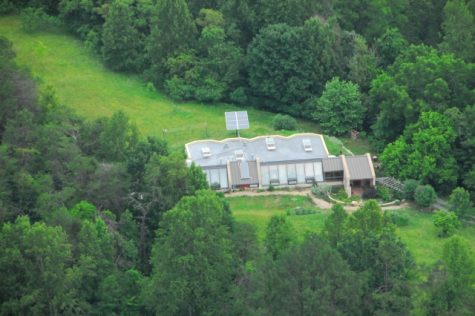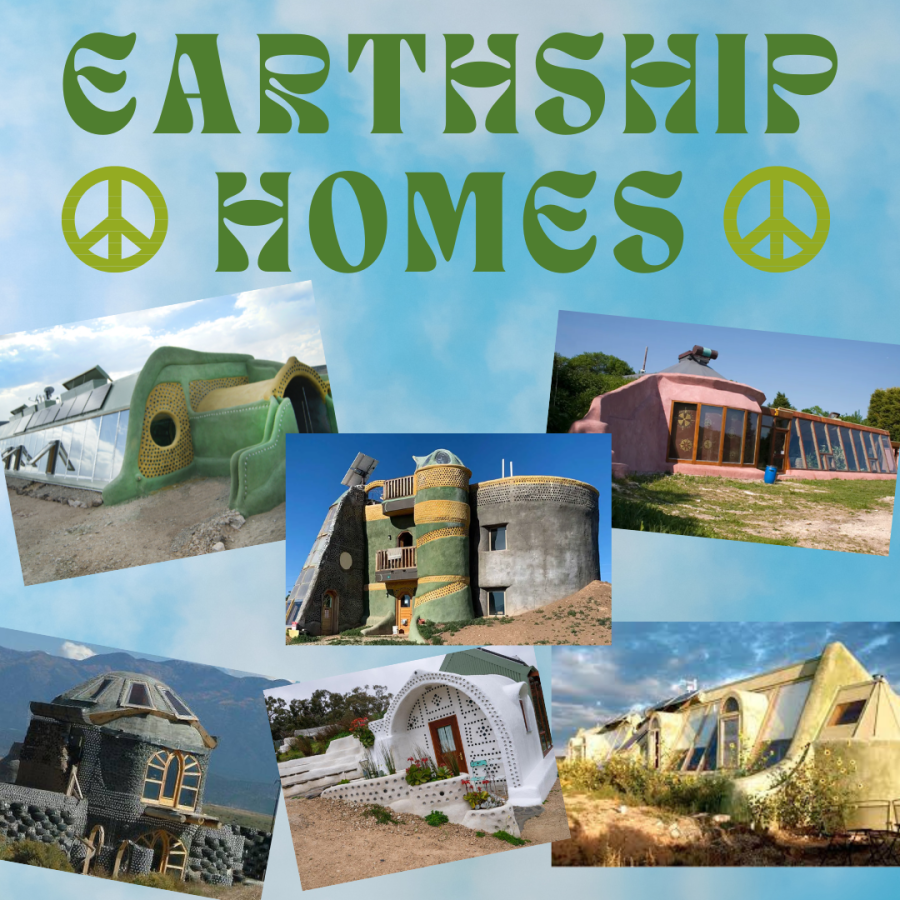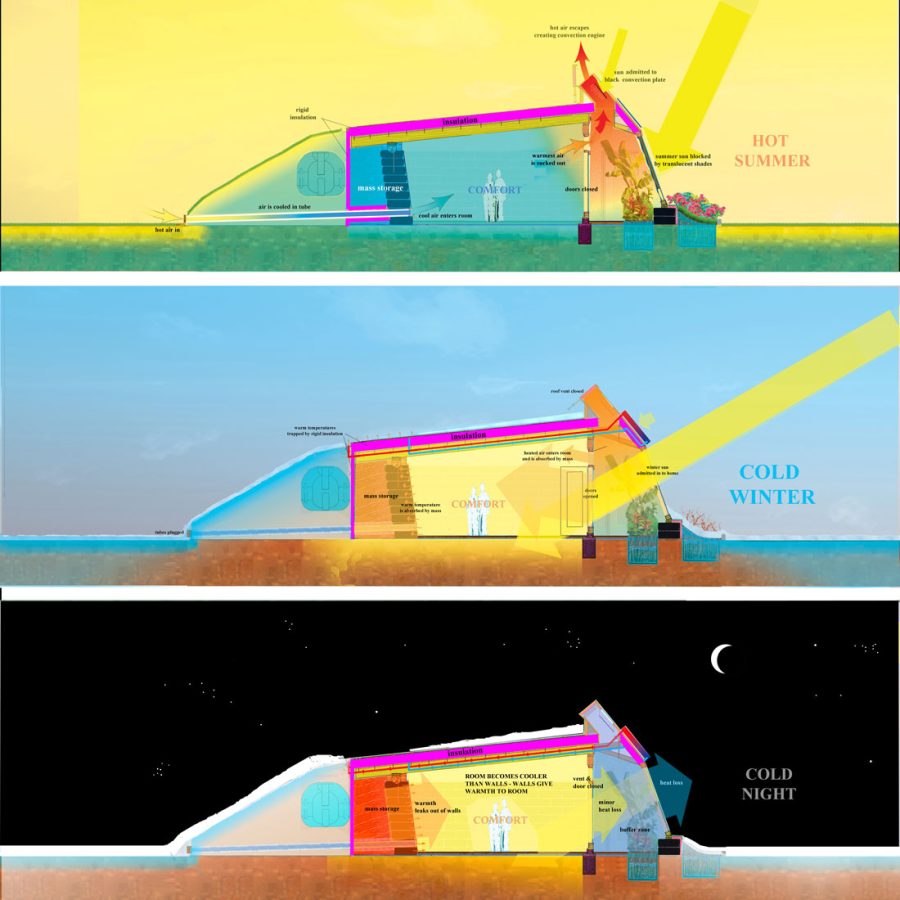What Are Earthship Homes?
Made with Canva.
March 23, 2023
Michael Reynolds began to develop the Earthship architecture style in the late 20th century. He sought to create a home that would use sustainable materials that were indigenous to the area or recycled, rely on natural energy sources and be off-grid, and be realistic for someone without construction skills to build. The name ‘Earthship’ is based on the idea of a spaceship, in the sense that it can provide everything needed for survival. Those who live in Earthship homes are essentially living off the land, constructing their homes in such a way that they use the Earth’s resources most effectively and sustainably.
The Earthship home is a popular choice for those looking to live a more sustainable and grounded lifestyle, as it incorporates multiple methods of acquiring amenities that are kind to the planet. To provide its inhabitants with water, the Earthship catches rainwater on the roof, and from there it is channeled through a series of filtration devices to then enter a cistern. The water from the cistern flows with gravity to a Water Organizing Module, which pumps the water into a pressure tank that may be released when a faucet or shower is turned on. Water may also be distributed to an allocated greenhouse area that is often incorporated into Earthships to make them self-sustainable in terms of food production.
For power, the Earthship uses the most abundant energy source available: solar. Solar panels are attached to the outside of the home, converting the shining sunlight into electricity to run appliances, charge batteries, and make energy for the utility grid. Solar energy is inexhaustible and renewable, making it a perfectly sustainable resource to run a home’s amenities.
Perhaps the most noteworthy feature of the average Earthship home is its heating and cooling system. The materials that the home is constructed of, such as rock, mud, or tires, serve as thermal mass that absorbs and stores heat from the sun. Most Earthships surround each living area with the thermal mass material on three sides and then have the southern side be made up of windows. Sunlight will enter through the glass windows and heat up the floors and walls of the space. Then at night, when the temperature outside drops below that of the heat stored in the thermal mass, heat is naturally released from the floors/walls into the space. During summertime, when the sun is higher in the sky, the Earthship stays cooler due to the sunlight not hitting directly through the windows, as well as the constant temperature of the Earth. Cooling in the home can also be enhanced with natural ventilation through underground cooling tubes.
You obviously don’t see Earthships every day, so it’s clear that some locations are better suited for them than others. Places with warmer climates are ideal for Earthships because they allow for the most effective absorption of heat, which is why the first Earthships were built in the desert of Taos, New Mexico, near the Rio Grande. Taos is the headquarters for the Reynolds’ Earthship Biotecture business, which helps people looking to lead a more sustainable lifestyle plan and construct Earthship homes. Taos is also home to many communities of people living in Earthship homes who make use of local recycled materials to minimize resource depletion, and generate their own power without contributing to our world’s growing carbon footprint. Many of these Earthship homes can be rented on AirBnB for visitors of Taos to stay in and experience living off of the land. Their Hobbit-style and futuristic attributes make these houses a marvel to many, some appearing especially whimsical with their owner’s touches adding a special flair. A few are even built into the hills of the Taos desert to really emphasize their oneness with the Earth and its resources.
I could only find one true Earthship home listed online that is located in North Carolina, on GreenHomesforSale.com. The home is located in Marshall, NC, about 25 minutes away from Asheville. It’s set in a rural location, atop a mountain, and comes with 4.72 acres of open meadow surrounded by woods overlooking the French Broad River. The seller describes the Earthship as “…about the most green/energy efficient design existing.” and says that “…temperatures in winter do not go below about 60 degrees due to the huge amount of thermal mass. Concrete and flag stone floors also absorb heat and allow relatively comfortable temperatures. A wood stove and a small propane stove may be used to bring up the temperature into the 70 degree range. In summer months skylights and east/west doors create a cross breeze for cooling. The home is off-grid, but if desired electric hook up is accessible. Construction of rammed earth, adobe walls, and salvaged materials make this a dark green home.” Despite the home’s location being untraditional for an Earthship, this home overcomes the obstacles of its climate, making it unique and something relatively unseen in NC.

In light of the benefits of Earthship homes, the question of whether they are feasible alternatives to living on the grid is important to consider. Despite all of the pros of this architectural style, there are many cons that contradict the purpose of these homes. First of all, it’s unlikely that you could raise all of the food you require in your Earthship alone. This conflicts with the supposed self-sufficiency Earthships are meant to provide. Another thing to consider is how about half of the materials used to build Earthships are recyclable and sustainable, but the rest is often concrete, which contributes to about 10% of the world’s greenhouse gases, again, canceling out any sustainability. Another material that is commonly used in Earthship construction is old tires, which seems like a good idea in theory because you’re reusing objects that can no longer serve their intended purpose, but they come with some consequences. The Ministry of Architecture writes “once the earthship settles, the breakdown of the rubber tires, which by nature was already in process, now happens in an enclosed environment. Which means, the gas expelled by the tires as they disintegrate collects in the walls, and then has the potential to release toxic vapors that you can’t smell but could make the inhabitants sick.” Not only is this harmful to the environment, defeating the purpose of Earthships, but this creates dangerous conditions to live in.
In terms of cost, Earthship homes are no cheaper to build and maintain than regular on-grid homes, that is unless you build the entire thing yourself with no help and obtain all the materials for free. The most basic Earthship homes still cost $150 per square foot, and if you enlist Earthship Biotecture to build your home for you, you’ll be paying $225 per square foot.
Earthships are becoming more and more popular as the climate crisis becomes increasingly apparent, with about 3,000 of them existing around the world today. It’s no doubt that an Earthship requires a specific kind of person to build and inhabit it, and it’s imperative to research all of its pros and cons before deciding whether this lifestyle is right for you. Environmental implications, cost, effort and time, and your personal needs are all important factors that will dictate if an Earthship could be your forever home.









